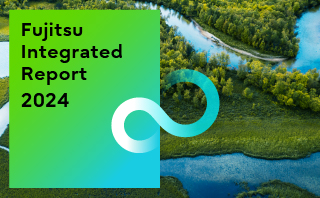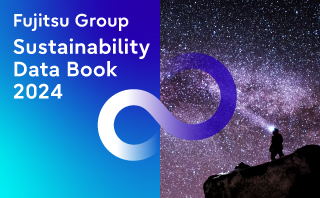-
Sustainability at Fujitsu Group
- Sustainability Management in the Fujitsu Group
- GRB(Global Responsible Business)Goals for FY2025
- GRB(Global Responsible Business)Goals and Achievments for FY2022
- Fujitsu's accessibility
- Stakeholder Engagement
- United Nations Global Compact
- SDG-related Activities in Fujitsu
- External Recognition and Awards
-
Global Responsible Business
- Environment
-
- Environmental Management
- The Fujitsu Group Environmental Vision on Climate Change
- Living in Harmony with Nature (Conservation of Biodiversity)
- Environmental Action Plan
- Environmental Data
- Environmental Communication
- Environmental Social Activities
- Disposal and Recycling of ICT products
- Environmental Considerations in ICT Products
- Governance
-
Data and Documents
- Fujitsu Group Sustainability Data Book 2024
- Social, Governance and Environmental data
- Independent Assurance Report

- GRI Standards / United Nations Global Compact (UNGC) principles Comparison Table
- SASB Standards Comparison Table
- Sustainability Information Disclosure Framework
- Link to regions responsible business reports
- Contact
- Sitemap
Non-Financial Indicators
Approach
To contribute sustainably to the Fujitsu Purpose in the long term, it is essential to foster trusted relationships with all stakeholders. The Fujitsu Group has integrated non-financial indicators into its core business activities, promoting their achievement alongside financial targets.
To measure and verify our positive impact on customers and society, and to strengthen the Foundation for Achieving Sustainable Development, we set non-financial targets in the Medium-Term Management Plan announced in FY2023. These targets include key performance indicators (KIPs) such as: Customer Net Promoter Score (NPS®)(*1), Employee Engagement (EE), Diversity Leadership (ratio of women in leadership roles), Productivity Index, and Greenhouse Gas (GHG) Emissions Reduction Rate. We are continuously monitoring the progress of these KPIs.
- (*1)Net Promoter, Net Promoter Score, and NPS are trademarks of NICE Satmetrix, Inc., Bain & Company, Inc. and Fred Reichheld.
Net Promoter ScoreSM (NPS®)
Customer Net Promoter ScoreSM (NPS®) (Customer NPS) is a metric used to objectively gauge the extent to which trusted relationships with customers helps create customer loyalty. Unlike customer satisfaction, which indicates the degree of satisfaction or dissatisfaction with a purchased product or service, customer loyalty is characterized by the ability to determine the degree of customer attachment and the likelihood of repeat purchases. The Fujitsu Group employs customer NPS as one of its non-financial indicators with the aim of realizing customer-centric management. By listening to our customers' views via NPS and offering services that appropriately suit their requirements, or by making proposals that anticipate their future needs, the value of the customer experience will be enhanced and our customer NPS will rise further. We believe that creating such a positive cycle will result in a boost to the corporate value of the Fujitsu Group.
As a structure to achieve this objective, at the working level we have appointed customer experience leaders in each region to take the lead in a timely manner in relation to improvement activities. Action plans and awareness of issues developed through discussions between CX leaders and frontline employees are shared with management, ensuring that customer issues are addressed at the frontline level and treated as management issues. This creates a system with a ‘feedback loop’ to propose continuous improvement, examine areas for investment, and verify the effectiveness of measures already taken.
 Customer Net Promoter ScoreSM (NPS®)
Customer Net Promoter ScoreSM (NPS®)
- Note:Given that the survey was conducted twice, FY2021 values were retroactively updated to the weighted average of the findings from the two surveys.
In line with the FY2022 continuous improvement result of +18.1 points and the FY2025 target of +20 points against a baseline of FY2022, we set a target of 6.5 points period-over-period for FY2023. Our activities resulted in an increase of +7.7 points period-over-period, exceeding the target. The Fujitsu Group is recognized, in particular, for providing proposals based on a deep understanding of the customer's business challenges, for experience in implementing DX, and for engaging in its own internal transformation.
However, we recognize that our consulting capabilities to address customer business challenges and our ability to implement innovative, advanced, and swift transformation require further improvement. Through further reskilling and accumulation of DX business model validations, the entire Fujitsu Group will enhance its ability to provide comprehensive business support.
Going forward, our Medium-Term Management Plan aims to boost the score by +20 points in FY2025 against a baseline of FY2022. Based on the results of the customer surveys conducted globally in FY2022 and FY2023, we will therefore focus on areas that require improvement, while continuing to improve the point scores in the areas that were evaluated as strengths.
Employee Engagement
The Fujitsu Group's greatest management resource is its employees, who are the source of the value provided to customers. Our experience suggests that highly engaged employees are better able to provide high-quality services to our customers, and that positive customer feedback correlates to an increase in employees' responsiveness to their work. We believe that improving the engagement of each employee leads to the growth of both the individual and the Fujitsu Group.
Based on this concept, to measure the sustainable growth of the Fujitsu Group we established Employee Engagement as a non-financial indicator that shows the mindset of employees and their empathy with the organizational culture. At Fujitsu, Employee Engagement is defined as “an indicator that shows the degree of employees’ motivation and attachment to work and their willingness to contribute independently in empathy with the company’s direction and purpose.” Employee Engagement can also be considered an indicator that illustrates the Fujitsu Group has the necessary human resources and other capabilities, including organizational culture, to gain the trust of customers as a DX partner.
The target Employee Engagement value of “75” is a figure that has been determined by benchmarking against global corporations. The actual scores can vary greatly across the Group, because they are impacted by the relevant company's business area, the business environments in different countries and regions, and the diversity of our employees’ countries of origin. While it is true that “75” is an ambitious target for the Fujitsu Group, we are nonetheless striving to achieve this goal with the aim of being on par with other global enterprises.
Fujitsu has implemented a framework comprising a Center of Expertise (CoE), a specialist team dedicated to creating highly engaged organizations, and Human Resource Business Partners (HRBP), a team of strategic HR partners who work with leaders at the highest level in organizations in Japan and in our overseas regions to boost engagement. As a specific initiative, we have introduced measures to broaden employees' workstyle options, after clarifying their individual purpose. This includes a semiannual survey conducted on a global basis to measure employee engagement. Survey items include questions about the employee’s sense of fulfillment in working for the Fujitsu Group, the connection between the Fujitsu Purpose and the employee’s own work, and the degree to which the employee’s individual strengths are demonstrated. Past surveys have clearly shown that senior and middle management in each organization must be the driving force in action-taking together with their team members to boost engagement. Strong relationships built on trust between managers and employees are also important. Survey findings are compiled on a manager-by-manager basis and are used to bolster support for management improvement by presenting each manager with the most appropriate Recommended Actions. Going forward, we plan to establish a data-driven cycle to improve organizational performance and individual wellbeing, leveraging the insights gained from analyzing engagement data to take even more effective action.
 FY2021
FY2021
(results)
 FY2022
FY2022
(results)
 FY2023
FY2023
(results)
 FY2025
FY2025
(target)
Employee Engagement
Diverse Leadership (ratio of women in leadership roles)
The DE&I vision for the Fujitsu Group includes “Build an inclusive and equitable culture where everyone belongs and can be completely themselves.” Gender is positioned as one of the five focus areas in the Global DE&I Vision & Inclusion Wheel.
To transition into an enterprise capable of sustainably generating innovations and providing value to customers while meeting the requirements of communities with diversified values, it is essential to create an environment and culture in which a diversity of people can each optimally leverage their different viewpoints and abilities. As a first step toward this objective, we have set the ratio of women in leadership roles as a new non-financial indicator. We based this on the results of research that determined “when the ratio of a minority group in an organization reaches 30% a chain reaction occurs that changes the organizational culture.” The target set for the end of FY2030 is to have a 30% ratio of women in leadership roles throughout the Fujitsu Group, with an interim milestone target of 20% by the end of FY2025.
In addition to the above, we will encourage various initiatives such as mindset transformation, positive action, and the promotion of Work Life Shift to improve the work environment.
 Ratio of women in leadership roles
Ratio of women in leadership roles
Per capita productivity
Up until FY2022, the Fujitsu Group was using DX Promotion Indices, that is, metrics for measuring the level of DX maturity (*2), for implementing DX policies such as vision sharing, mindset, talent development, IT reform, business process reform, and business model reform. This laid the foundation for transformation, enabling the company to continuously implement transformation based on company-wide strategies.
In order to move into the next stage of transformation, we need to demonstrate that DX is contributing to business transformation and increased competitiveness, and is a driver for generating greater corporate value. From FY2023, we have set a new ‘productivity indicator’ for operating income per capita, which is an indicator for measuring business efficiency. The target as at the end of FY2025 is set at 40%+ against a baseline of FY2022. As one of the activities to achieve this target, we are pursuing an initiative centered on data visualization and cause-and-effect analysis as productivity indicators. We believe that visualizing our own current position will encourage discussion and decision-making on productivity from the perspective of management and the workplace respectively, leading to actions that will increase individual as well as corporate productivity. In order for the Fujitsu Group to become a true DX company, we will achieve greater efficiency in time usage, communication, and business processes through the use of AI and digital technologies based on more sophisticated IT investments. We will implement productivity improvements in collaboration and interaction with various initiatives, unfettered by preconceived ideas or stereotypes.
- (*2)Note 1: Maturity level metrics tool for assessing digital business transformation on a six-point scale of 0 to 5. Consists of seven “Indicators related to DX promotion by corporate management, and the framework therefor”, and two “Indicators related to the development of platform IT systems for enabling DX.”
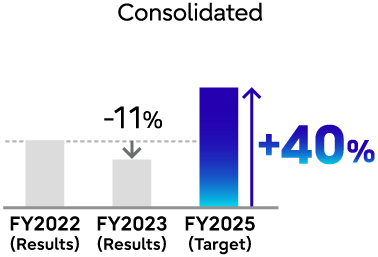
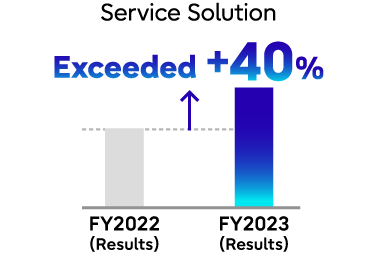
Per capita productivity
Reduction of GHG Emissions
The Paris Agreement (COP21), adopted in December 2015, set out a long-term, shared worldwide goal of limiting the average global temperature increase to considerably less than 2℃ and preferably 1.5℃ over pre-Industrial Revolution temperatures, as well as the goal of carbon neutrality (net zero emissions) by the second half of this century. Subsequently, following a review of climate change impacts (loss, damage, etc.) based on the latest scientific knowledge, it was declared at the COP26 Glasgow Agreement that the preferred 1.5℃ target would now become the actual target and that the world must aim to achieve net zero by mid-century (around 2050). These rapid changes led the Fujitsu Group to announce a target of net zero for GHG emissions in its supply chain by FY2040, with an interim target of net zero for GHG emissions in Fujitsu’s own business areas by FY2030. To help achieve these objectives, we released the Environmental Action Plan (Stage XI). This plan runs up to FY2025, a milestone on the path to the targets, and will give shape to our specific initiatives as we work toward the realization of carbon neutrality.
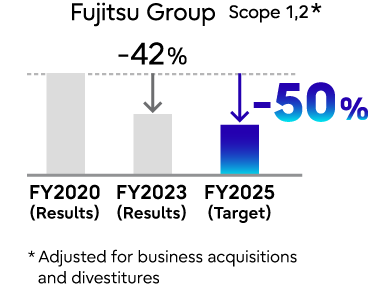
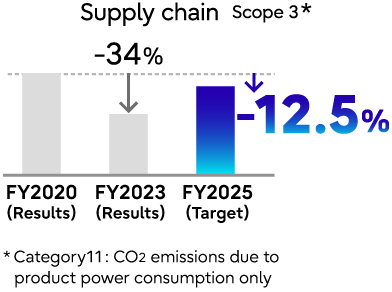
GHG emissions reduction rate FY2025 target and FY2023 results (compared to FY2020)
As a leading SX company, Fujitsu has a role to play in applying technology to help solve challenges for customers and society while expanding and enhancing the value provided as we collaborate with customers and partners to achieve a sustainable future. It is therefore essential to confirm the global trends and the actions taken in regard to climate change challenges, because a delayed response could lead to a loss of business opportunities. Against this backdrop, we consider the reduction of GHG emissions to be a critical issue and are working on it as one of our non-financial indicators.

